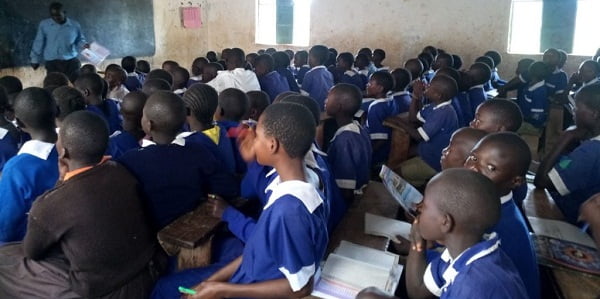Roy Hezron
Girls performed better than boys in English activities in the grade 3 Monitoring Leaners Progress (MLP) assessment carried out last year.
A majority of Grade 3 learners however generally met expectations in performance during the assessment.
A report released by the Ministry of Education through Kenya National Examination Council, shows that a total of 1,282,150 learners participated in the assessment of which 604,522 (47.15 per cent) were girls and 677,628 (52.85 per cent) were boys from 37,374 schools countrywide.
“The conduct of the 2019 MLP Grade 3 was successful and a national analysis of learners’ performance indicates that majority performed at level 3 (Meeting Expectation) and level 4 (Exceeding Expectations) in various tasks and strands”, read the report.
The audit report was done between 1st July and 30th August 2019 by the Kenya National Examination Council to track the performance of grade 3 learners and to gauge the progress of the Competency Based Curriculum (CBC), across the 47 counties.
On the whole, learners’ progress in performance was summarized as – meeting expectations in all subject areas.
In English language activities, learners met expectations at level 3 across all the four tasks; listening and speaking/singing skills, reading aloud/singing, reading comprehension and language structures and writing skills that were assessed.
Leaners performed best in listening and speaking/singing skills at 35.85 per cent, and reading comprehension and language structures at 33.03 per cent.
However, it was identified that they were weaker in writing skills at 32.60 per cent and reading aloud at 31.68 per cent.
Girls performed better than boys in all English tasks with 36.59 per cent of them meeting expectation (level 3) in listening and speaking skills as compared to the boys at 35.19 per cent.
They were also on top in the strand of reading aloud with a total of 33.57 per cent of the girls exceeding expectation (level 4) compared to the boys at 25.61 per cent in the same level.
In English activities, the report indicates that a high percentage of learners in rural schools performed well at exceeding expectation in reading comprehension, language structures and functions at 25.07 per cent and writing skills at 23.91 per cent.
They fared better than their counterparts in urban schools who exceeded expectations in the same subject area at 14.36 per cent and writing skills at 14.20 per cent.
In mathematical activities performance, learners met expectation at level 3 across the three strands with the best achievements being realized in measurement at 44.55 per cent representing 536,836 learners, followed by geometry at 41.37 per cent (498,478).
Geometry recorded the highest proportion of learners performing at level 1, below expectation at 15.51 per cent (186,869 learners).
It was followed by numbers at 10.57 per cent (representing 120,562) and Measurement at 10.01 per cent (127,336 learners).
Exceeding expectation at level 4 in mathematics activities, geometry recorded the highest proportion of learners compared to all other strands at 37.07 per cent (446,666 learners) followed by numbers at 25.51 per cent (307,382) and measurement at 23.96 per cent (288,708).
Performance of mathematics activities as per the school location indicates that majority of last year’s grade 3 learners in both rural and urban areas performed at meeting expectation (level 3) in all the strands.
Schools in urban areas however had a higher percentage of learners than schools in rural areas at meeting expectation (level 3) and exceeding expectation (level 4) in numbers and geometry strand, while schools in rural areas posted a higher percentage of learners attaining below expectation (level 1) in all strands.
According to age performance in the mathematics activities, a majority of the learners who performed at exceeding expectations were over-age (10 years and above) in all the strands, while more grade-age appropriate learners performed well at meeting and exceeding expectation.
For instance, in measurement and geometry, age appropriate learners registered the highest percentage of 45.36 per cent and 40.94 per cent respectively.
Notably, there were higher percentages of age appropriate learners performing well at exceeding expectation in all the strands.
The performance by gender in mathematical activities was comparable for both boys and girls with boys exceeding expectation by 36.47 per cent (231,986 learners) in the geometry and the girls by 37.75 per cent (214,680).
The highest percentage of boys performed at below expectation in the same strand by 16.20 per cent (103,082 learners) compared to 14.73 per cent of the girls (83,787).
In the special needs education (stage-based) pathway, the performance in communication, social and pre-literacy skills was at meeting expectations across five out of the six activities.
The percentage of learners who met expectations in skills such as responding to visual, auditory and tactile stimuli were both at 43.24 per cent (959 learners), and using or responding to cues, signs and common signals in communication for effective interaction at 43.08 per cent (955 learners) which was commendable.
With regard to integrated learning assessment for special needs education pathway, majority of learners performed at meeting expectation (level 3) at a percentage of at least 33.43 percent in all the seven activities.
Skill of exhibition of social interaction had the highest proportion of learners at 43.61 per cent meeting expectation.
The lowest proportion of learners performing at this level was in cutting out number shapes at 33.43 per cent.
The report indicates that 41.61 per cent of public schools grade 3 teachers were computer literate.






